With the rise of online shopping, businesses need to utilize various strategies and techniques to promote and sell their products or services. That’s when e-commerce becomes king! If you’re looking forward to starting an e-commerce business, it’s necessary to understand the basics of eCommerce marketing.
From search engine optimization (SEO) to joining influencer marketing platforms, there are several methods you can incorporate into your ecommerce marketing strategies based on your business. In this article, we’ll discuss some of the most important strategies to follow for driving more sales.
Let’s get to know more about e-commerce marketing and strategies to enhance it.
What is ecommerce marketing?
Before getting into the strategies, let’s have a deeper look into e-commerce marketing and how it works. Every business has a goal, which is generating revenue. In order to do so, various marketing strategies are implemented.
Ecommerce marketing is an essential component of any successful online business, which involves a range of tactics and techniques that aim to drive traffic, boost sales, and build customer loyalty.
By using a combination of these tactics, you can create a successful eCommerce marketing strategy that will help you increase brand awareness, reach your target audience, and boost sales.
Types of E-commerce Marketing
For an online business to succeed, marketing is everything. When it comes to an e-commerce business, you need to know the different types of ecommerce marketing. You can implement all of them into your marketing strategy, or only choose one of them. That may depend on your marketing budget.
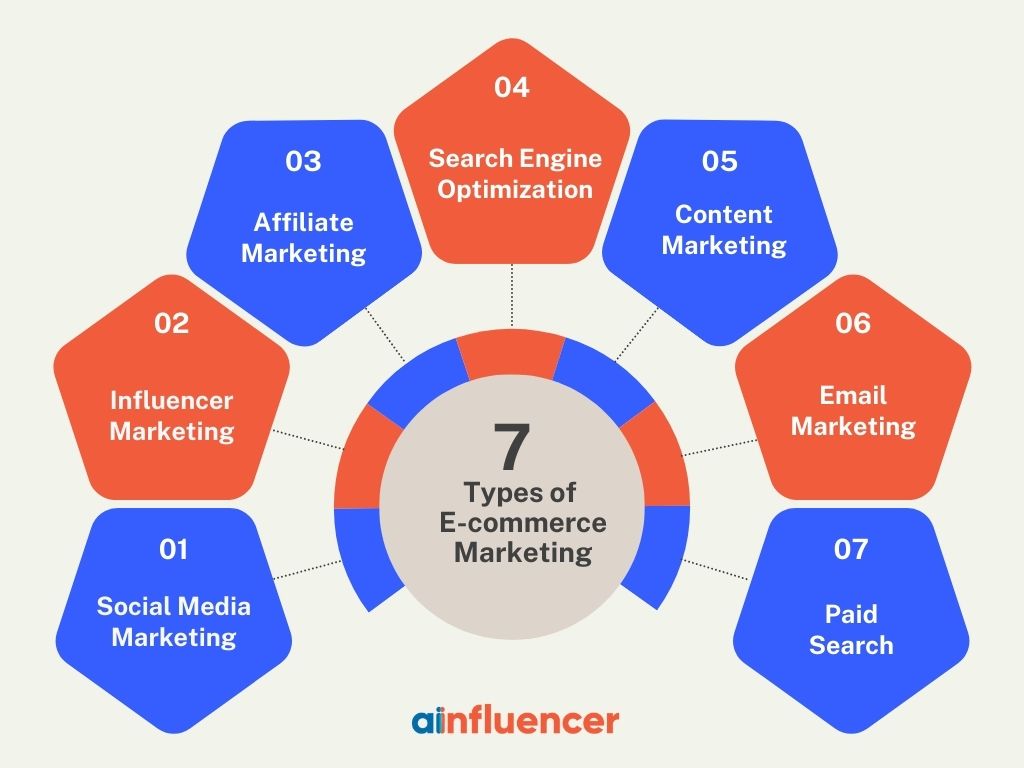
1-Social Media Marketing
Being active on social media platforms is essential for every business because nowadays most of your potential customers are using these platforms. Research shows that the average time that internet users spend on social media is 151 minutes. So, you should create appealing content to grab the attention of more users during this time.
Furthermore, it is essential to discover the social media network that most of your customers might be using. You should know what type of content is best aligned with your business. Since you have products to sell, it is crucial to showcase your products and talk about their features. But, try to be more creative.
2-Influencer Marketing
Talking about social media, nothing will be as effective as influencer marketing. Influencers are considered credible and trusted people on social media who have so many followers. Therefore, to introduce your brand to more people, they are the perfect options.
Influencers can create different types of content to reach different goals. They can drive more traffic to your website, increase brand awareness, or help you get more views and engagement on your own accounts. Consequently, partnering with an influencer can have several benefits for your business.
You may wonder how you can find the best influencers for collaboration. Don’t worry! You’re at the right place because Ainfluencer is here to help you.
Ainfluencer: The Best Influencer Marketing Platform
Ainfluencer can help brands find influencers for their marketing purposes, or create influencer marketing campaigns to share with influencers. This marketplace is 100% free, which means neither brands nor influencers have to pay any fee while joining the platform. Furthermore, brands can easily search for influencers based on category, location, gender, language, hashtags, and the number of followers.
It should be noted that nano influencers are also available on this marketplace, so if you are a startup with a limited budget, you can find the perfect nano influencers for your ecommerce marketing.
Check out the following video to learn more about creating an influencer marketing campaign on Ainfluencer.
3- Affiliate Marketing
One of the best methods that can help an ecommerce business sell more products and make a name on the market is affiliate marketing. In this marketing strategy, the ecommerce business partners with other websites, influencers, or content creators to promote its products or services. Then, it pays a commission to the affiliates for each sale, lead, or click that they generate through their referrals.
In fact, affiliate marketing is a type of performance-based marketing that is popular among online businesses because it can provide a high return on investment (ROI).
Three types of affiliate marketing programs are:
- Cost-Per-Action,
- Cost-Per-Sale,
- Pay-Per-Click.
4- Search Engine Optimization
If you run an online store, then you know that getting people to visit your site is only half the battle. Once they’re there, you need to make sure they stick around long enough to buy something.
That’s where search engine optimization (SEO) comes in. SEO is a process of optimizing your website so that it appears as high as possible in search engine results pages (SERPs).
Here are some tips that can help you enhance the SEO of your e-commerce website:
- Optimize your website for mobile use. Make sure it is responsive for different devices.
- Use the correct keywords. Do your research before writing any content.
- Organize your site structure and navigation.
- Create a link-building strategy to drive organic visits.
- Optimize your page titles, meta descriptions, and images.
- Incorporate different tools to audit your SEO and find its errors.
Pro Tip: Using SEO content writing services can be helpful to improve your website ranking
5- Content Marketing
Content is the most critical part of every business, especially ecommerce websites because that’s how usually their potential customers can find them. Therefore, it has a direct impact on SEO.
Content marketing is a strategy that involves creating and sharing content to attract and engage customers. Ecommerce businesses can use content marketing to drive traffic to their websites and convert leads into customers.
Content can take many forms, such as
- Blog Posts,
- Infographics,
- Videos,
- Social Media Posts.
It’s important to create content that is engaging, relevant to your target audience, and provides value to them. Also, it should be published regularly.
6- Email Marketing
There are several ways to connect with your customers and keep them up-to-date on your company’s latest products and services, one of them is email marketing.
Like any other marketing tool, email marketing must be used correctly in order to be effective. Here are some tips for using email marketing effectively:
- Make sure your email list is up-to-date.
- Send interesting and engaging content.
- Keep your emails short and to the point.
- Use images and videos to break up the text.
- Make sure your emails are relevant to your customers.
- Personalize your emails whenever possible.

Note: If you want to use emails to stay connected with your customers, we recommend you read more about email marketing strategies to make the most out of this type of ecommerce marketing.
7-Paid Search
Paid advertising can be a great way to get your products in front of more people. It can also be a wonderful solution to increase sales and grow your business.
This kind of advertising can be done through various platforms, including Google AdWords, Facebook Ads, and Instagram Ads. When choosing a platform for paid advertising, it is important to consider your target audience and the goals of your campaign.
What is Ecommerce Advertising?
There is another definition that may seem similar to Ecommerce marketing but it has a slight difference. We’re talking about Ecommerce advertising. What is the difference between these two concepts?
E-commerce Marketing Vs E-commerce Advertising
- Ecommerce marketing refers to the strategies that are going to enhance brand visibility, optimize the user experience, and build customer trust. On the other hand, E-commerce advertising is the process of paying ads to drive more traffic and increase sales.
- Each concept has a different approach. Ecommerce marketing types include a range of methods like influencer marketing, SEO, email marketing, etc. Ecommerce advertising types are text ads, banner ads, video ads, etc.
- Ecommerce marketing strategies are long-term and mostly organic, but ecommerce advertising is short-term and paid.
Both concepts are essential for the success of an online business. Furthermore, you should note that there is no best ecommerce marketing strategy. Find something that works best for you and stick to it.
The next step to implement an ecommerce marketing strategy is knowing its different types.
10 Best Ecommerce Marketing Strategies to Grow your Business
There are many different aspects to consider when creating your ecommerce strategy, such as who your target audience is, what type of content you will produce, and how you will promote your business.
Creating a successful ecommerce marketing strategy takes time and effort, but it’s worth it in the end. Before marketing your ecommerce website, ask yourself these questions:
- What are your sales expectations?
- How large is your current market?
- What target group do you want to reach?
- What resources do you need?
- How do you want your product to be perceived?
- What are your competitors doing?
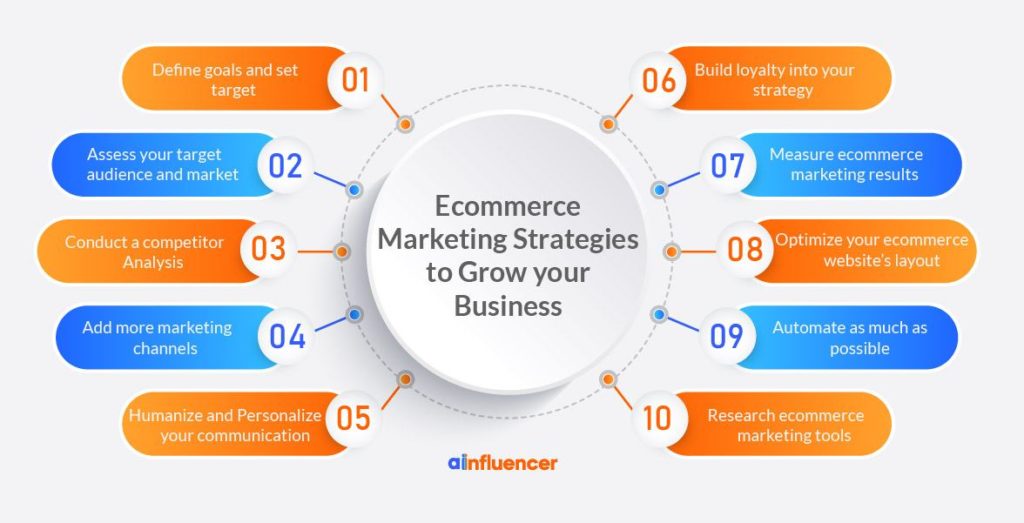
1. Define goals and set targets
Whether you’re a small business or a large corporation, setting goals and measuring progress is critical to success. There are many different types of goals that can be set for ecommerce, ranging from sales targets to customer satisfaction levels.
Know your objectives. What are you hoping to achieve with your ecommerce business? Whether you want to increase revenue, improve customer satisfaction, or expand your market reach. Knowing your objectives is a vital starting point of your ecommerce marketing strategy.
Whatever your goals may be, it’s important to make sure they’re specific, measurable, achievable, relevant, and time-based.
2. Assess your target audience and market
When it comes to ecommerce, it’s important to know your target audience. After all, you’re selling to people, and you need to know who those people are so you can create an effective ecommerce marketing strategy.
First, consider what you’re selling. What’s the purpose of your ecommerce website? Is it to sell products to the general public, or is it to sell products to a specific niche market?
This includes understanding your customers’ demographics (e.g. age, gender, location) and psychographics (e.g. what motivates them, their interests).
Once you have a good understanding of your target audience, you can then design and market your products and services accordingly and take your brand advertising to another level. For example, if you are targeting young adults, you may want to use social media to market your products.
3. Conduct a competitor Analysis
Looking to stay ahead of the competition in ecommerce?
Check out what your rivals are doing. Keeping tabs on your competition is a key part of any good ecommerce marketing strategy.
By watching what your competitors are up to, you can learn from their successes and mistakes, and adapt your own strategies accordingly.
This can give you a sense of what products they sell, how they sell them, and what prices they charge.
There are a number of ways to keep track of your competitors’ online activities. One way is to use tools like Ahrefs to see what websites your competitors are getting traffic from.
4. Add more marketing channels
Utilizing different marketing channels for your ecommerce marketing can help you build a successful ecommerce brand and increase traffic and sales. It can be a great way to reach new customers and grow your business.
There are a number of different marketing channels you can use, such as:
- Social Media,
- Search Engine Optimization,
- Email Marketing,
- Paid Advertising.
Each channel has its own unique benefits that can help you reach your target market and boost revenue.
For example, the SEO channel is among the most vital ecommerce marketing solutions for your business. By optimizing your site for search engines, you can increase traffic from organic search results.
5. Humanize and Personalize your communication
In a world where digital communication is the norm, it’s more important than ever to find ways to humanize your interactions with customers.
By personalizing your communication, you can create a more positive customer experience that will keep them coming back. Customers want to feel like they are talking to a real person.
There are many ways to personalize your communication, but some of the most effective methods include using customer data to create personalized messages, addressing customers by name, and using emoticons and other expressions of emotion.
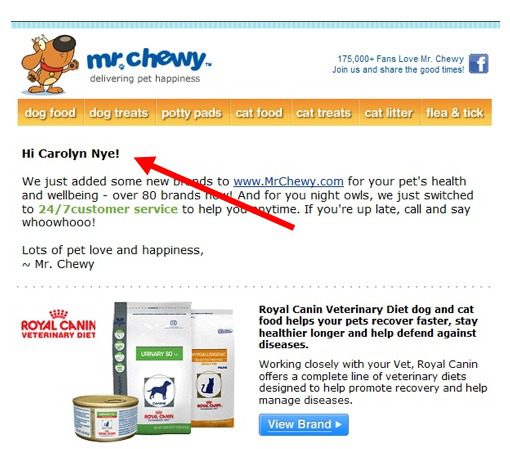
When businesses humanize their communication with customers, they are more likely to form a connection, increase brand engagement, and earn their loyalty.
6. Build loyalty into your strategy
Loyalty should be one of the key goals of any ecommerce strategy. It can be a challenge to create and maintain loyalty, but there are many ways to do this, and it will vary depending on your business.
Some general tips include offering rewards for frequent purchases, providing exclusive deals and discounts to loyal customers, and sending personalized emails with special offers.
You can also make it easy for customers to track their purchase history and see how close they are to earning rewards.
Make sure your customers feel valued and appreciated. Respond to their questions and concerns quickly, and go above and beyond to help them out.
It’s important to build loyalty into your ecommerce marketing strategy from the beginning, so you can continue to grow and succeed in the future.

7. Measure ecommerce marketing results
Every business needs to analyze its marketing efforts to see if it has any progress or requires optimization. Measuring your e-commerce marketing results is the best way to determine whether you are making progress.
First, it’s important to define your ecommerce marketing objectives at the outset to effectively measure their effectiveness in the end. Once you know your goal, you can develop a plan and track your progress along the way.
Measuring results can help you determine what’s working and what’s not, so you can make necessary adjustments and continue to improve your ecommerce marketing strategy.
There are a number of key performance indicators (KPIs) you can use to measure your ecommerce marketing results, including website traffic, conversion rates, and sales figures.
Each of these measures can tell you something different about how your marketing is performing.
8. Optimize your ecommerce website’s layout
A well-designed ecommerce website can be a valuable asset to your business, helping you attract new customers. However, if your website is not properly laid out, it can actually have the opposite effect, causing customers to leave your site without making a purchase.
In order to ensure that your website is as effective as possible, you need to make sure it is responsive and pay attention to its layout, and design.
For example, make sure your categories are easy to find and well-organized so visitors are able to find what they’re looking for quickly and easily.
Pro Tip- Optimize for Mobile
According to a study conducted by Google, 61% of users are unlikely to return to a website that is not mobile-friendly. This means that if your ecommerce website is not optimized for mobile devices, you’re missing out on a big piece of the pie.
9. Automate as much as possible
Running an online store can be quite challenging and requires a lot of effort. It can be overwhelming to manage and track different things such as inventory, orders, shipping, and customers all at once.
One way to make your life a little easier is to automate as much of your ecommerce marketing as possible. This can mean setting up automatic ordering and shipping systems or using tools to help you keep track of your inventory.
Automating your ecommerce process can bring in multiple benefits. It can streamline your operations, reduce errors, improve efficiency, and enhance customer experience. Ultimately, automation can help you save time and money while improving your customer experience.
By automating tasks, you can improve your efficiency and reduce the chances of mistakes. More importantly, you have the time to focus on your ecommerce strategy than operation.
10. Research ecommerce marketing tools
In order to be successful in your business, it is important to have a good ecommerce marketing strategy. There are many different marketing tools available to help you make the most of your strategies.
Let’s check out some of these useful tools.
Top Ecommerce Marketing Tools
It is essential to analyze your marketing efforts via different tools to see if it was successful or where it requires improvement. The good news is that most ecommerce marketing tools are free to use so you can easily assess your marketing strategies.
Let’s get to know some of the best ecommerce marketing tools that are required for every business.
1-Marketing Analytics Tools
You can analyze your marketing performances with marketing analytics tools.
These ecommerce marketing tools are software solutions that allow businesses to track, measure, and analyze their marketing performance. They can help businesses understand their customers, optimize their campaigns, and improve their ROI.
The most popular marketing analytics tools is:
Google Analytics
This is a free tool that tracks and reports website traffic, behavior, and conversions. Google Analytics is a powerful tool that can be used to measure the performance of your ecommerce website. It can help you track how many people are visiting your site, where they are coming from, and what they are doing when they get there.
By setting Google analytics goals you can track interactions with your website that you deem to be the most valuable to your business.
2. Ecommerce Platforms
Every online business need software solution to manage and enhance their website and online shop. A platform is a type of business model that provides a foundation for other businesses to build on. Ecommerce platforms are those that provide a digital marketplace for buying and selling goods and services.
Ecommerce platforms are perfect tools for businesses of all sizes, from small businesses to large enterprises. Additionally, they are great ecommerce marketing solutions if you are at the beginning of your journey.
There are many different ecommerce platforms available. Each has its own set of features and benefits.
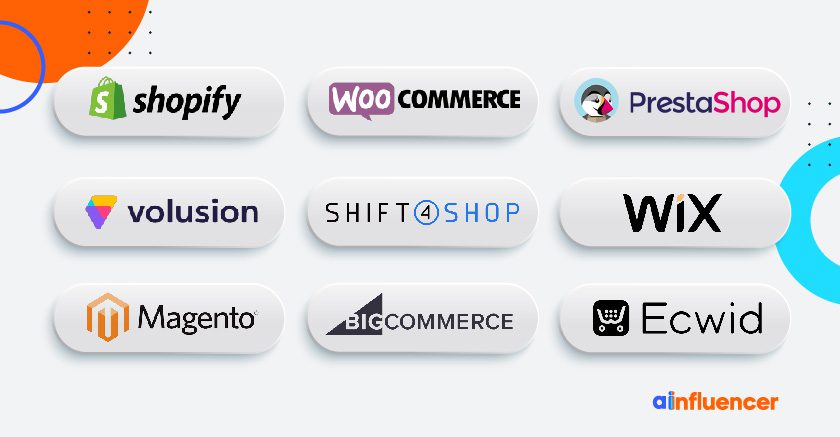
Here are the 3 mostly-used platforms for ecommerce websites:
- Shopify: This ecommerce platform allows users to create and customize their online stores, list the products, process payments, track orders, and more. Shopify is a comprehensive solution for your sales needs.
- WooCommerce: The best thing about WooCommerce is that it’s free and you can easily integrate it into your WordPress website. WooCommerce allows you to turn your WordPress site into a fully functional online store.
- BigCommerce: Another powerful platform to use in your ecommerce marketing is BigCommerce. It has tools to help you manage your online store, such as product catalog, SEO, analytics, marketing, and more.
3. Customer Service and Support
One of the most important things for ecommerce businesses is providing great customer support.
There are a few different types of customer support for ecommerce businesses. The first is self-service support, which is when customers help themselves to the information available on the company website. This type of support is usually best for simple issues that can be resolved by reading through the website’s FAQs or troubleshooting guides.
If a customer can’t find what they need or the issue is more complicated, they can move on to the next type of support, which is live chat. These LiveChat tools can help you provide better customer support.
Good customer support can make the difference between a happy, loyal customer and one who never comes back.
4. Retargeting Tools
Retargeting is a form of online business advertising that helps you reconnect with people who have already shown an interest in your products or services.
When someone visits your website, retargeting technology follows them around the web with ads for your business. It can be an incredibly effective way to boost website traffic and sales conversions.
For example, if someone visits your website but does not make a purchase, you can show them an ad for your website when they visit other websites.
For this purpose, you can choose one of the following tools:
- Criteo: This tool helps you re-engage with previous customers and lead them to purchase your product or service.
- AdRoll: This multi-functional system helps the ecommerce websites to retarget the users with unfinished shopping carts.
- ReTargeter: As the name indicates, this tool is especially designed to manage, track, and enhance social media engagements by retargeting previous viewers.
5. Conversion Rate Optimization
The measures you take to convert as many site visitors as possible is called conversion rate optimization. You’ve worked hard and/or paid for your traffic so you want it to result in sales.
Traffic without revenue is nothing. There are various tactics you can use on your website to drive sales:
- Push notifications
- Live chat
- User reviews & user-generated content (UGC)
- Choosing guides
- VR fitting and placement tools e.g. for fashion or furniture
Conclusion
Ecommerce marketing may seem complicated with all these countless products, business models, and target groups, and it is impossible to pinpoint just one best practice. What works for one seller with a specific product won’t necessarily work for another selling something else to another audience in a different market.
By creating an ecommerce marketing strategy that works best for you, you can stand out from your competitors, reach more targeted people, and grow your business.
Don’t underestimate the power of social media in marketing your business. Join Ainfluencer now and create your first free influencer marketing campaign.
FAQs
Ecommerce is the process of buying and selling goods or services through the internet. This can be done through a website or an app. Digital marketing, on the other hand, is the use of digital technologies to promote and sell products or services. This can include things like email marketing, social media marketing, and search engine optimization.
There is no one-size-fits-all answer for the best ecommerce strategy. The best ecommerce strategy for your business will depend on your products, your target market, and your budget. But one of the most effective ecommerce marketing strategies is search engine optimization(SEO).
SEO can help you rank higher in search results, attract more visitors to your site, and boost sales.
Some of the most common tools include search engine optimization, paid advertising, and social media marketing. Each of these tools has its own strengths and weaknesses, so it’s important to choose the ones that will work best for your website.
The main goal of Ecommerce marketing is to use techniques and strategies to bring more traffic to your online store, which should lead to more sales and customers.
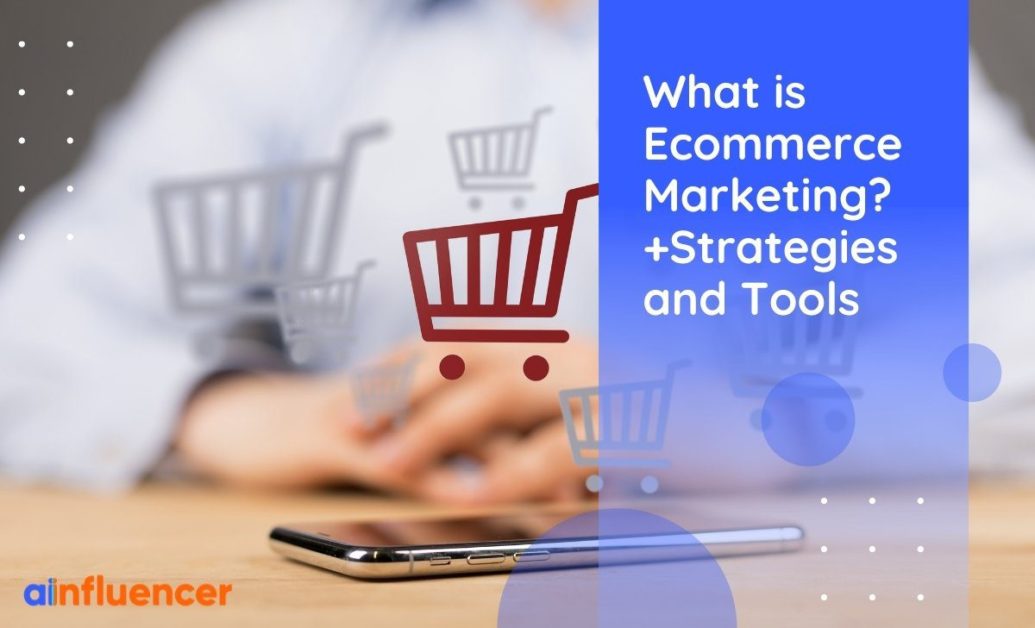

![Read more about the article Top 15 Brazilian Fitness Influencers On Instagram [2024 Non-Celebrity]](https://blog.ainfluencer.com/wp-content/uploads/2022/05/Top-Brazilian-Fitness-Influencers-On-Instagram-2022-Non-Celebrity-300x182.png)





![Read more about the article 30 Best Australian Fitness Influencers On Instagram [2024]](https://blog.ainfluencer.com/wp-content/uploads/2022/05/Best_Australian_Fitness_Influencers_On_Instagram_To_Grow_Your_Brand-300x182.png)
